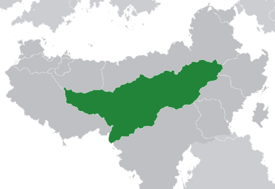User:Char/sandbox: Difference between revisions
mNo edit summary |
mNo edit summary |
||
| Line 68: | Line 68: | ||
|area_magnitude = | |area_magnitude = | ||
|area = | |area = | ||
|area_km2 = | |area_km2 = 2,621,088 | ||
|area_sq_mi = | |area_sq_mi = | ||
|area_footnote = | |area_footnote = | ||
| Line 79: | Line 79: | ||
|population_census = 33,010,572 | |population_census = 33,010,572 | ||
|population_census_year = 2019 | |population_census_year = 2019 | ||
|population_density_km2 = | |population_density_km2 = 12.6 | ||
|population_density_sq_mi = | |population_density_sq_mi = | ||
|population_density_rank = | |population_density_rank = | ||
Revision as of 22:32, 9 April 2021
This article is incomplete because it is pending further input from participants, or it is a work-in-progress by one author. Please comment on this article's talk page to share your input, comments and questions. Note: To contribute to this article, you may need to seek help from the author(s) of this page. |
State of the Central Scipian Accord | |
|---|---|
|
Flag | |
 | |
| Capital and largest city | Agnannet |
| Official languages | Tamashek |
| Recognised national languages | Zarma Gharbaic |
| Ethnic groups (2019) | |
| Demonym(s) | Charnean |
| Government | Unitary one-party presidential republic under a military junta |
| Makhia Anaba Meslar (acting) | |
| Makhia Anaba Meslar | |
| Legislature | Agraw Imegharan |
| Area | |
• Total | 2,621,088 km2 (1,012,008 sq mi) |
| Population | |
• 2020 estimate | 33,023,983 |
• 2019 census | 33,010,572 |
• Density | 12.6/km2 (32.6/sq mi) |
| GDP (PPP) | estimate |
• Total | $101 billion |
• Per capita | $5779.45 |
| Gini | 35.9 medium |
| HDI | 0.701 high |
| Currency | Charnean Dinar (CDR) |
| Date format | mm.dd.yyyy |
| Driving side | right |
Charnea (Tamashek: ⵞⴰⵔⵏⴻⴰ; Gharbaic: تشارنيا; Hebrew: טשאַרנעאַ), formally the State of the Central Scipian Accord (SCSA), is a political union in Scipia bordered by the Messidor Union to the northwest, Alanahr to the northeast, Fahran and Kembesa to the east and M'biruna to the southeast. Originally established as a federation of constituent states, the SCSA is now a unitary state made up of seven administrative subdivisions and encompasses numerous ethnic and religious groups, with Imuhagh, Zarma, and Gharbaic peoples making up the largest ethnic contingents, while religious groups present include White Pilgrims, Yen, Jews and Asalists which practice their traditions exclusively or in conjunction with the highly syncretic native Charnean faith known as Kaharnism which deifies the ancient Charnean ruler Kaharna. The Kaharnic faith in its many variations is highly prevalent and serves as a unifying force in a highly diverse nation, causing Charnea to often be referred to as the Kel Kaharna (Tamashek: ⴽⴻⵍ ⴽⴰⵀⴰⵔⵏⴰ, lit. "Those of Kaharna"). The SCSA is currently ruled by the Council for Administrative Reorganization (CAR), a military junta which has been in power since the 2011 Charnean coup d'etat and is led by its Chairman, General Martuf Lamine who led the 2011 coup and now serves as de facto commander-in-chief of the Charnean military and chief executive of the national government.
Modern day Charnea was once part of three great Scipian empires, the Yoruba-Hausa led Sunset Empire, the Zarma led Hsewa Empire as well as the Imuhagh led Empire of Charnea for which the country is named. Various Deshretic domains as well as the Tamashek speaking Amazigh confederations of the northern and western deserts have also existed within what is now Charnea, eventually being subsumed into the Empire of Charnea. At its peak between 1350 and the 1420s, the Empire of Charnea controlled a majority of the Scipian continent and was one of the largest contemporary military powers in the world. Throughout the early modern period, the empire's frontiers receded to what was considered its core territories, a region roughly equivalent to the modern day borders of the SCSA. From 1906-1909, the empire underwent a period of escalating civil conflict known as the Charnean Revolutionary Period eventually leading up to the dissolution of the Charnean Empire into several newly independent states and the creation of the Central Scipian Accord in 1911, a treaty which created a supranational organization for resolving disputes between the former nations of Charnea. By 1925, cohesion between the signatory nations had returned with the resurgence of Charneanism, resulting in the federalization of the treaty signatories and the formation of the State of the Central Scipian Accord along the lines of the former empire with a new republican government. 27 years later in April of 1952 a new constitution was ratified, known today as the April Document, which abolished sub-divisional autonomy and transitioned the SCSA into a unitary state.
In the past century, Charnea has experienced two revolutions, four dictatorships, seventeen coup d'etat attempts both failed and successful, the ten year Ninvite War with neighboring Fahran, and the longest running civil conflict in the world. Many of its internal conflicts can be traced back to the dissolution of the Empire of Charnea and the aftermath of the ensuing events, particularly the unfulfilled promises of independence, self determination and autonomy which were made to many Charnea's myriad ethnic groups living under the often incompetent and heavy handed late Imperial rule. Another cause of political instability has been the outbursts of periodic infighting between factions of the county's upper class over control of Charnea's valuable natural recourses, which include petroleum and precious metals like gold and platinum. However, despite these frequent disruptions and the occasional imposition of economic sanctions by foreign powers, the Charnean economy based largely on the processing and export of its natural wealth has become moderately prosperous.
